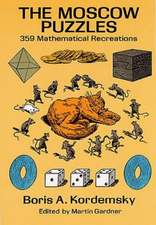From Computing to Computational Thinking
Autor Paul S. Wangen Limba Engleză Paperback – 9 oct 2015
Successful applications in diverse disciplines have shown the power of CT in problem solving. The book uses puzzles, games, and everyday examples as starting points for discussion and for connecting abstract thinking patterns to real-life situations. It provides an interesting and thought-provoking way to gain general knowledge about modern computing and the concepts and thinking processes underlying modern digital technologies.
Preț: 531.11 lei
Preț vechi: 663.89 lei
-20% Nou
Puncte Express: 797
Preț estimativ în valută:
101.63€ • 106.38$ • 84.59£
101.63€ • 106.38$ • 84.59£
Carte tipărită la comandă
Livrare economică 31 martie-14 aprilie
Preluare comenzi: 021 569.72.76
Specificații
ISBN-13: 9781482217650
ISBN-10: 1482217651
Pagini: 288
Ilustrații: 130 black & white illustrations, 20 black & white tables
Dimensiuni: 156 x 234 x 20 mm
Greutate: 0.41 kg
Ediția:1
Editura: CRC Press
Colecția Chapman and Hall/CRC
Locul publicării:Boca Raton, United States
ISBN-10: 1482217651
Pagini: 288
Ilustrații: 130 black & white illustrations, 20 black & white tables
Dimensiuni: 156 x 234 x 20 mm
Greutate: 0.41 kg
Ediția:1
Editura: CRC Press
Colecția Chapman and Hall/CRC
Locul publicării:Boca Raton, United States
Notă biografică
Paul S. Wang , PhD, is professor of computer science at Kent State University, Ohio. He received his PhD from MIT. He has published 10 computer science textbooks, all of which have been well-received in the US and worldwide. Several have been translated into other languages.
Cuprins
Why Does the Chicken Cross the Road? Bits, Bytes, and Words. True or False. Who Is the Master? Hello There! Home Sweet Homepage. Keeping It Safe. Solve That Problem. Data Everywhere. Get That App.
Descriere
This easy-to-understand guidebook gives you the tools for understanding and using Computational Thinking (CT). It does not assume experience or knowledge of programming or of a programming language, but explains concepts and methods for CT with clarity and depth. Puzzles, games, and everyday examples provide starting points for discussion and for connecting abstract thinking patterns to real-life situations. The book lays an interesting and thought-provoking path to gaining general knowledge about modern computing and the concepts and thinking processes underlying modern digital technologies.















